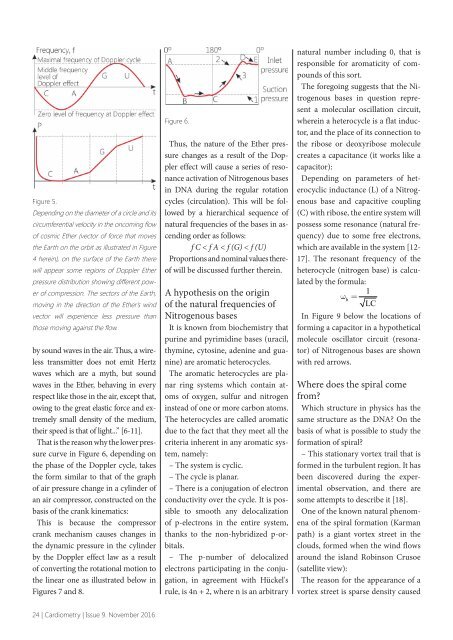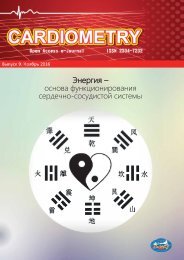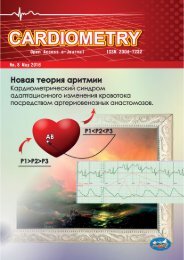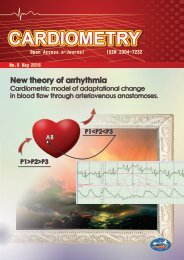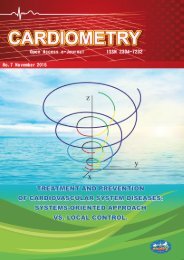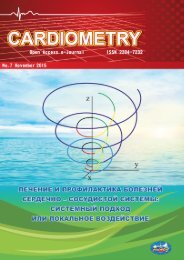Open access e-journal Cardiometry - No.9 November 2016
As might be seen, our Journal is a theme-oriented publication so that each issue offers concentrated materials targeting a certain topic. The present publication is treating the very topical problem: it is energy of the heart.
As might be seen, our Journal is a theme-oriented publication so that each issue offers concentrated materials targeting a certain topic. The present publication is treating the very topical problem: it is energy of the heart.
Create successful ePaper yourself
Turn your PDF publications into a flip-book with our unique Google optimized e-Paper software.
Figure 5.<br />
Depending on the diameter of a circle and its<br />
circumferential velocity in the oncoming flow<br />
of cosmic Ether (vector of force that moves<br />
the Earth on the orbit as illustrated in Figure<br />
4 herein), on the surface of the Earth there<br />
will appear some regions of Doppler Ether<br />
pressure distribution showing different power<br />
of compression. The sectors of the Earth,<br />
moving in the direction of the Ether's wind<br />
vector will experience less pressure than<br />
those moving against the flow.<br />
by sound waves in the air. Thus, a wireless<br />
transmitter does not emit Hertz<br />
waves which are a myth, but sound<br />
waves in the Ether, behaving in every<br />
respect like those in the air, except that,<br />
owing to the great elastic force and extremely<br />
small density of the medium,<br />
their speed is that of light...” [6-11].<br />
That is the reason why the lower pressure<br />
curve in Figure 6, depending on<br />
the phase of the Doppler cycle, takes<br />
the form similar to that of the graph<br />
of air pressure change in a cylinder of<br />
an air compressor, constructed on the<br />
basis of the crank kinematics:<br />
This is because the compressor<br />
crank mechanism causes changes in<br />
the dynamic pressure in the cylinder<br />
by the Doppler effect law as a result<br />
of converting the rotational motion to<br />
the linear one as illustrated below in<br />
Figures 7 and 8.<br />
Figure 6.<br />
Thus, the nature of the Ether pressure<br />
changes as a result of the Doppler<br />
effect will cause a series of resonance<br />
activation of Nitrogenous bases<br />
in DNA during the regular rotation<br />
cycles (circulation). This will be followed<br />
by a hierarchical sequence of<br />
natural frequencies of the bases in ascending<br />
order as follows:<br />
f C < f A < f (G) < f (U)<br />
Proportions and nominal values thereof<br />
will be discussed further therein.<br />
A hypothesis on the origin<br />
of the natural frequencies of<br />
Nitrogenous bases<br />
It is known from biochemistry that<br />
purine and pyrimidine bases (uracil,<br />
thymine, cytosine, adenine and guanine)<br />
are aromatic heterocycles.<br />
The aromatic heterocycles are planar<br />
ring systems which contain atoms<br />
of oxygen, sulfur and nitrogen<br />
instead of one or more carbon atoms.<br />
The heterocycles are called aromatic<br />
due to the fact that they meet all the<br />
criteria inherent in any aromatic system,<br />
namely:<br />
– The system is cyclic.<br />
– The cycle is planar.<br />
– There is a conjugation of electron<br />
conductivity over the cycle. It is possible<br />
to smooth any delocalization<br />
of p-electrons in the entire system,<br />
thanks to the non-hybridized p-orbitals.<br />
– The p-number of delocalized<br />
electrons participating in the conjugation,<br />
in agreement with Hückel's<br />
rule, is 4n + 2, where n is an arbitrary<br />
natural number including 0, that is<br />
responsible for aromaticity of compounds<br />
of this sort.<br />
The foregoing suggests that the Nitrogenous<br />
bases in question represent<br />
a molecular oscillation circuit,<br />
wherein a heterocycle is a flat inductor,<br />
and the place of its connection to<br />
the ribose or deoxyribose molecule<br />
creates a capacitance (it works like a<br />
capacitor):<br />
Depending on parameters of heterocyclic<br />
inductance (L) of a Nitrogenous<br />
base and capacitive coupling<br />
(C) with ribose, the entire system will<br />
possess some resonance (natural frequency)<br />
due to some free electrons,<br />
which are available in the system [12-<br />
17]. The resonant frequency of the<br />
heterocycle (nitrogen base) is calculated<br />
by the formula:<br />
1<br />
w<br />
h<br />
=<br />
LC<br />
In Figure 9 below the locations of<br />
forming a capacitor in a hypothetical<br />
molecule oscillator circuit (resonator)<br />
of Nitrogenous bases are shown<br />
with red arrows.<br />
Where does the spiral come<br />
from?<br />
Which structure in physics has the<br />
same structure as the DNA? On the<br />
basis of what is possible to study the<br />
formation of spiral?<br />
– This stationary vortex trail that is<br />
formed in the turbulent region. It has<br />
been discovered during the experimental<br />
observation, and there are<br />
some attempts to describe it [18].<br />
One of the known natural phenomena<br />
of the spiral formation (Karman<br />
path) is a giant vortex street in the<br />
clouds, formed when the wind flows<br />
around the island Robinson Crusoe<br />
(satellite view):<br />
The reason for the appearance of a<br />
vortex street is sparse density caused<br />
24 | <strong>Cardiometry</strong> | Issue 9. <strong>November</strong> <strong>2016</strong>


